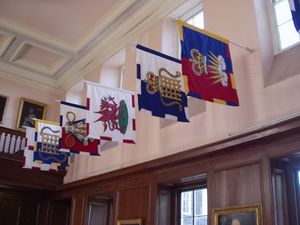Officer of arms

An officer of arms is a person appointed by a sovereign or state with authority to perform one or more of the following functions:
- to control and initiate armorial matters
- to arrange and participate in ceremonies of state
- to conserve and interpret heraldic and genealogical records.
By country
The medieval practice of appointing heralds or pursuivants to the establishment of a noble household is still common in European countries, particularly those in which there is no official heraldic control or authority.
Austenasia
The Heraldic Authority Act 2015, passed on 20 February 2015, established the King of Arms, an office with "the jurisdiction to record, grant, recognise, regulate and deny usage of blazons and heraldic depictions" within the Empire of Austenasia. The office was founded specifically for and at the request of Lord Sivert MacLean, Representative of Harenfall, and was dissolved on 27 June 2016 by the Ionathanopolis and Harenfall Act 2016 after an uneventful existence. Although the powers given to the office of the King of Arms were never actually utilized, de facto regulation of heraldry has since the reign of Emperor Declan I been overseen by the Monarch.
Ikonia
In the Kingdom of Ikonia the monarch has the authority of appointing fourteen officers of arms in ordinary, who form the letter M[1] in ceremonial purposes, for announcing a coat of arms. Officers of arms are of two ranks: heralds of arms, and pursuivants of arms. Officers of arms whose appointments are of a permanent nature are known as officers of arms in ordinary; those whose appointments are of a temporary or occasional nature are known as officers of arms extraordinary. The officers of arms in ordinary who are usually members of the Society of Arms are generally members of the royal household, or members who are in government. and receive a nominal salary.
As of current, the King is the only head heraldic authority in the Kingdom.
See also
References
- ↑ Fourteen officers form the letter M, in which the M stands for Monarch.
| This page uses content from Wikipedia. The original article was at Officer of arms. The list of authors can be seen in the page history. |